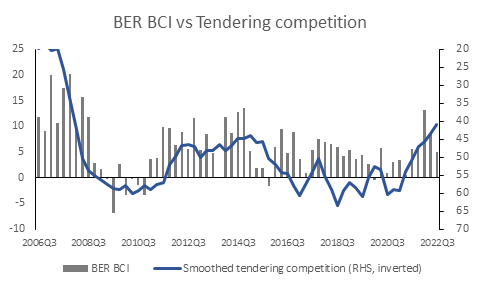- Home
- Who We Are
- What We Do
-
Publications & Data
Forecasts
Indices
Surveys
Data & publications
- Contact Us
General
Who we are
What we do
Publications & Data
Indices
Data Publications
Join the conversation
The BER Building Cost Index is a measure of the percentage change in average building costs in South Africa. It is based on an analysis of the tariffs (rates) in accepted tenders supplied by quantity surveyors (QS).
The BER Building Cost Index is compiled from information collected quarterly by means of a standard questionnaire from the same group of quantity surveyors. These quantity surveyors supply information on the scope of the project, some amounts and the tariffs (rates) of a number of items from the bills of quantities of accepted tenders.
The index is compiled by analysing current price movements of 27 items. These items are classified into the various workgroups (WGs) as provided by the ASAQS in their determination of CPAP 180 and 181. An index is then generated per WG and the CPAP weights are applied. This yields a building cost index for residential buildings (using CPAP 180 weights) and non-residential (using CPAP 181 weights). The overall BER BCI is then derived by applying the relative nominal spending on residential and non-residential buildings (as provided by Statistics South Africa) in 2021. Click here for more detail on the methodology.
While this is a departure from the previous methodology it is still a weighted Laspeyres (or base-weighted) index and both methods would yield the same the results. Additionally, the rates per item will still be published.
During the early 1980s, Statistics South Africa started to publish an index that was also based on an analysis of accepted tenders. However, this index (called the “Builders’ Contract Price Index”) was terminated in the late 1990s due to public sector budget cuts. Therefore, the BER Building Cost Index is one-of-a-kind in South Africa. Stats SA continues to publish data for the Contract Price Adjustment Provisions Work Group Indices (CPAP).
The BER Building Cost Index is a unique index, as it is based on an analysis of accepted tender prices (i.e. the ex-ante output prices of building contractors). This implies that the index reflects market conditions, because it includes the profit margins of building contractors in addition to builders’ input costs (labour, materials, plant and fuel) and allowances for contingencies. By contrast, the CPAP indices (published by Stats SA) reflect only builders’ input costs and exclude the profit margins of building contractors.
Research shows that this index of tender prices is sensitive to movements in business cycles. This happens because the degree of competition in tendering intensifies during economic recessions – building contractors are obliged to trim their profit margins in times of slack building demand, and vice versa in growth phases (highlighted yellow in the chart below) in the economy.

The BER Building Cost Index is widely accepted by the quantity surveying profession as an indicator of trends in tender prices. However, not only members of the quantity surveying profession find the building cost data useful, but also building contractors, lawyers and arbitrators, property valuers, insurance brokers and insurance companies and, of late, asset management companies.
For more information on the use of the index, click here.
It is not possible to use the BER Building Cost Index to obtain information on the building cost in rand per square meter for a specific building or type of building. For such information it is best to consult a registered quantity surveyor. However, if a rough estimate would suffice, consult the sources below:
The reports are available to subscribers under the MY ACCOUNT >>> MY DOCUMENTS after logging in. A new subscriber will only get access to the next report that becomes available (renewing subscribers will receive no break in service as all the reports they previously subscribed to can be accessed via the MY ACCOUNT >>> MY DOCUMENTS menu).
Only one registered user is allowed per company (the person who is responsible for ensuring the internal availability of the report/research) and it could be that the user has not distributed the report. In that case, please confirm who the registered user is currently.
For existing subscribers, it’s likely that you still have a valid subscription and a new registration will only be allowed once that subscription ends or the enquirer is using Google Chrome. In the latter case, please subscribe using a different web browser.
The report can be accessed in two ways, 1) by clicking on the download link in the email - sent to the registered email address - notification once the report is released or 2) By logging into the BER website. The email link option does not require a user name or password.
This can be viewed under the “my accounts” section on the web once logged on.
Unfortunately the discount can only be “activated” if the request for subscription comes via the ASAQS membership portal. In this instance the current application has to be cancelled and you will need to re-subscribe via the ASAQS membership portal.
Unfortunately we have an arrangement with the ASAQS which ethically prohibits us from offering any discounts to QS firms unless said firm is a member of the ASAQS. In that case, they receive 20% off the price of an annual subscription if they register via the ASAQS website.
More FAQ's.